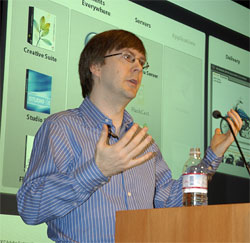Adobe starts opening the kimono on its Apollo platform


Lynch identified the five key mediums through which most content consumption takes place -- electronic documents, publishing (mainly print), rich internet applications, Web sites, and interactive media and how the Apollo program, currently in pre-release, is looking to help content and application developers target each with a rich experience. To wit, the company's forthcoming Apollo program will build on the company's biggest strongholds: its Portable Document Format (PDF) and Flash by providing deeper integration between the two at the client, tool, and infrastructure layers.
Although Flash and PDF pretty much monopolize the Internet in their areas of respective functionality, Microsoft has finally started to set its sites on Adobe with corresponding technologies such as Windows Presentation Foundation, XAML, and the XML Paper Specification (XPS, formerly known as Metro). So, while it appears as though it's just a natural evolutionary step for the company, Adobe's timing in terms of refreshing its product line and rearchitecting the fundamentals of its platform should come as no surprise. While Lynch didn't cast aspersions on any of Microsoft's efforts, his notes regarding the involvement of Adobe's technologies in the open source communities and international standards as well as their agnosticism to target platforms (Windows, Mac, Linux, as well as mobile platforms where other players like Nokia are involved) simply echo the difficulty Microsoft may have in loosening the grip of either Flash or PDF as de facto if not de jure standards.
Some impressive notes regarding Adobe's market penetration to date:
- Between Flash Player and PDF, the company's reach extends into over 700 million PCs and 150 million devices
- The Flash Player 8 upgrade reached 85 percent market penetration in 9 months. Lynch claimed this to be the fastest update of any client technology in the world.
- There are already 250,000,000 PDF-formatted documents on the Web.
Lynch hypothesized "pretty much every day, around the world, you're interacting with something that has been touched by Adobe Software." Given my own personal content consumption habits, I'm not one to argue the point. It is definitely true of me.
Once the Apollo platform is completed and out (version 1.0 is targeted for a 2007H2 release), one of the chief selling propositions is that whether your Web apps are targeting Flash or HTML, you'll be able to build it using some common APIs that form Apollo's foundation and the collection of Adobe tools that can access those APIs. Third parties will obviously be open to work with the APIs as well. In addition to the Apollo foundational elements, the main parts of the platform include the designer/development tools (Creative Suite 3 (shipping later in 2007H1), Studio 8, and Flex Builder), the client software (the Flash Player and Acrobat Reader), Adobe's server products (the Flash Media Server, Flashcast, Livecycle+Flexedata services, and Cold Fusion), and its software (Acrobat and Connect).
Adobe's 2007 pipeline also includes a new version of Flex called "Moxie" (2007H2) and is considering offering a standard out-of-the box Flash-based video player under the codename Philo. Today, many of the video players on the Web are Flash-based, but they're homegrown instead of Adobe-provided.
Lynch also discussed how Flash technology is being used as a persistence mechanism to solve the so-called off-line problem and use a prototype of an eBay application to show how the application can continue to run even when the connection is down. However, should those applications involve structured data, Lynch noted that even though XML data structure are supported, none of Adobe's tools are particularly adept at modeling those structures and subsequently deploying them into a Flash-based application involving off-line persistence of data. To the extent that one of the Holy Grails for software development tool companies like Adobe is how to enable unsophisticated developers to develop sophisticated applications, this is an area of weakness that I anticipate Adobe will have to address (probably through acquisition or partnership).
Another weakness in terms of finding that Holy Grail is the lack of an API browser. Adobe sees Apollo has a highly mashable program and here, at the Engage event, is demonstrating how third party APIs are being pulled into the final products (Apollo apps). But one major shortcoming is that there's no way to browse or bookmark third-party APIs in a way that they can be dragged and dropped onto an Apollo application in development. According to one company official, that's on the to-do list.
See also: Adobe Engage: Fighting Against The Architecture of the Space by James Governor who is also here at the event.